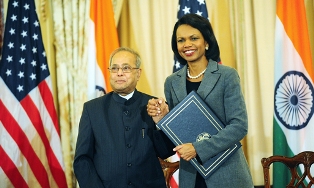As the US-Indian civilian nuclear cooperation agreement is finally signed, the chairman of Nuclear Power Corporation of India Ltd (NPCIL) has spoken about what India expects to gain from the deal in terms of reactors and uranium supplies.
 |
| The agreement is signed (Image: US Department of State) |
During the signing ceremony, which Rice described as "truly an historic occasion", she said that "many thought this day would never come, but doubts have been silenced now." Rice said that Indian prime minister Manmohan Singh had "literally risked his political future for this agreement, and then remade his government to gain the support that he needed. And President Bush first saw the potential and the need for transforming the US-India partnership all the way back in 1999 when he was still the governor of Texas, and he's made it one of his highest priorities."
However, she added, "Let no one assume, though, that our work is now finished. Indeed, what is most valuable about this agreement is how it unlocks a new a far broader world of potential for our strategic partnership in the 21st century, not just on nuclear cooperation but on every area of national endeavour."
"In the last three years, |
President Bush signed into law the '123 Agreement' on nuclear cooperation with India on 8 October. The bill established the legal framework for an agreement to come into effect that allows US nuclear suppliers to resume trade with India for the first time in 34 years.
Bush and Singh signed a declaration in July 2005 aimed at ending India's isolation in nuclear trade. The text of a proposed deal was amended in the USA by the Hyde Act, and the revised deal then faced a long battle for approval by the Indian parliament. Singh eventually reorganised his coalition government to force the bill through. The agreement was approved by the US Congress at the beginning on 1 October.
India eager to trade
With regards the construction of new reactors, Jain told Business Standard that, besides the US-India agreement, it still needs to ratify the agreement with France and that an agreement with Russia is scheduled to be signed at the beginning of December during a visit by the Russian President to India.
In an interview with Business Standard, he said, "In the last three years, we've had detailed discussions with all the four vendors - General Electric, Westinghouse, Areva and Rosatom. To begin with, we are planning to negotiate with each one of them for one pair of reactors each (not less than 1000 MW) with the clear understanding that there will be a basket of such reactors, that the relationship would extend to six to eight reactors." He added, "You can't start the construction of all the 20-30 reactors simultaneously."
Jain told Bloomberg, "The next step is to ensure fuel supplies for our ongoing and planned projects. We need long-term supplies and we're looking to buy stakes in assets." NPCIL plans to place orders for up to 2000 tonnes of uranium before the end of 2008, according to Jain. He said that the company is in talks for long-term contracts and is also willing to invest up to $1 billion to buy stakes in as many as four uranium mines overseas.
NPCIL has approached companies in Canada, Kazakhstan, Africa and Russia for long-term supplies, Jain said. He said that India has yet to approach Australia regarding supplies. He added that the company is also examining possible joint ventures in mining and acquiring stakes in uranium mines that have not yet been developed due to lack of funds.




_18570.jpg)
_16159.jpg)
_18938.jpg)
_33584.jpg)





